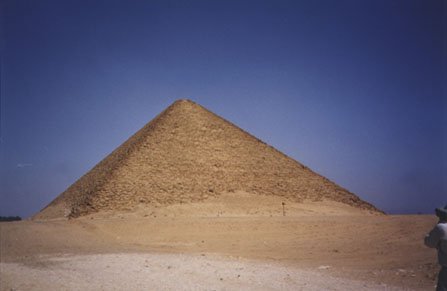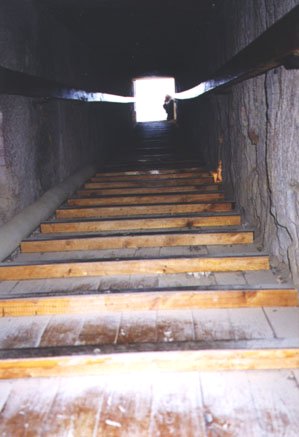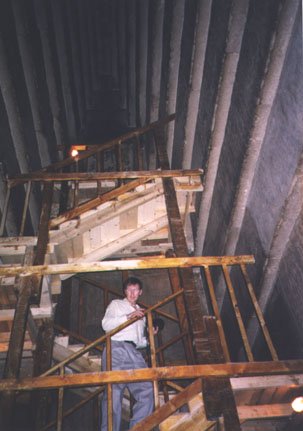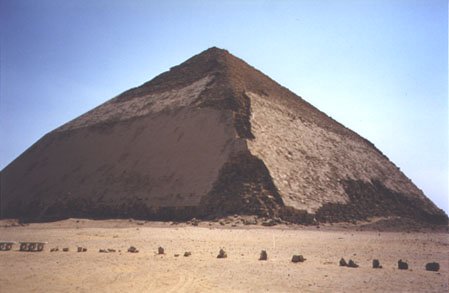DASHUR

A view of the Red Pyramid of King Snefru at the site of Dashur. This area used to
be a restricted military zone, off limits to the public. In recent years they have opened
up the area containing these pyramids to the public, making it possible to once again see
these magnifienct precursors to the large pyramids at Giza. The Red Pyramid is believed to
be the finest Egyptian pyramid outside of Giza, and is perfect in its form and dimensions.
It gets its name from the iron oxide in its stone, which gives the pyramid a reddish hue.
This was the only pyramid open to the public at Dashur while we were there.

The entrance shaft of the Red Pyramid, from the inside looking up the shaft
towards the sunlight. (The pyramid's door guardian appears backlit, partially blocking the
entrance/exit. The two lines of light from the entrance are actually light reflecting off
of the smooth wooden handrails that go down both sides.) This shaft is similar to some of
the large Giza pyramids in its size and sharp downward angle. The floor is coated with
wood to which rectangular bars have been afixed at regular intervals, providing a form of
foot stop to keep you from sliding down the shaft. There's enough sand on the wood's
surface to make it slippery, so the bars really come in handy. Because of limited height
of the shaft you have to proceed almost doubled over at the waist, which becomes even
harder for someone like me (tall, with a backpack, and trying to film his descent/ascent
on a camcorder). Something about the angle, bars, and being hunched over really put a
strain on my calf muscles, and after exploring three pyramids in one day my legs were
definitely complaining.

View of the inside of one of the chambers of the Red Pyramid. I'm climbing up the
stairs to the next level. These stairs are obviously modern additions for the tourist's
sake. The upper chambers were the most interesting, and while it made an interesting video
it doesn't really work well as subjects for still photography. Note the vaulted ceiling
(shaped like the top of a capital "A"). It reminded me of some of the vaulted
ceilings that I had seen in the Mayan temple pyramids of Central America.

The famous "Bent" Pyramid at Dashur. This pyramid gets its name from the
change in in the angle of its exterior sides, which changes to a more shallow angle about
halfway up its height. Conventional archeologists say that structural faults became
apparent during construction, and the lesser angle was chosen to cut down on the amount of
weight exerted by the the top half of the pyramid. This pyramid still retains its smooth
casing stones on part of its exterior, and though they have suffered deterioration over
the ages, they still give you an idea what this pyramid would have looked like when it was
new and in one piece. Unfortunately, you are allowed to get no closer than the nearby
parking lot (whose edge is denoted by the line of stones in the foreground), so you can't
examine the casing stones up close, and you can only see the pyramid from one angle. There
was another pyramid visible in the distance at Dashur, called the Black Pyramid of
Amenemhet III. It appeared as a ruined mound from which protruded a black structural core,
and is only recognized as a pyramid if you are told that that's what it used to be. The
Pyramid of Amenemhet III is also off limits to visitors, though its black granite
pyramidion (top-most stone) can be seen in the Cairo Museum.